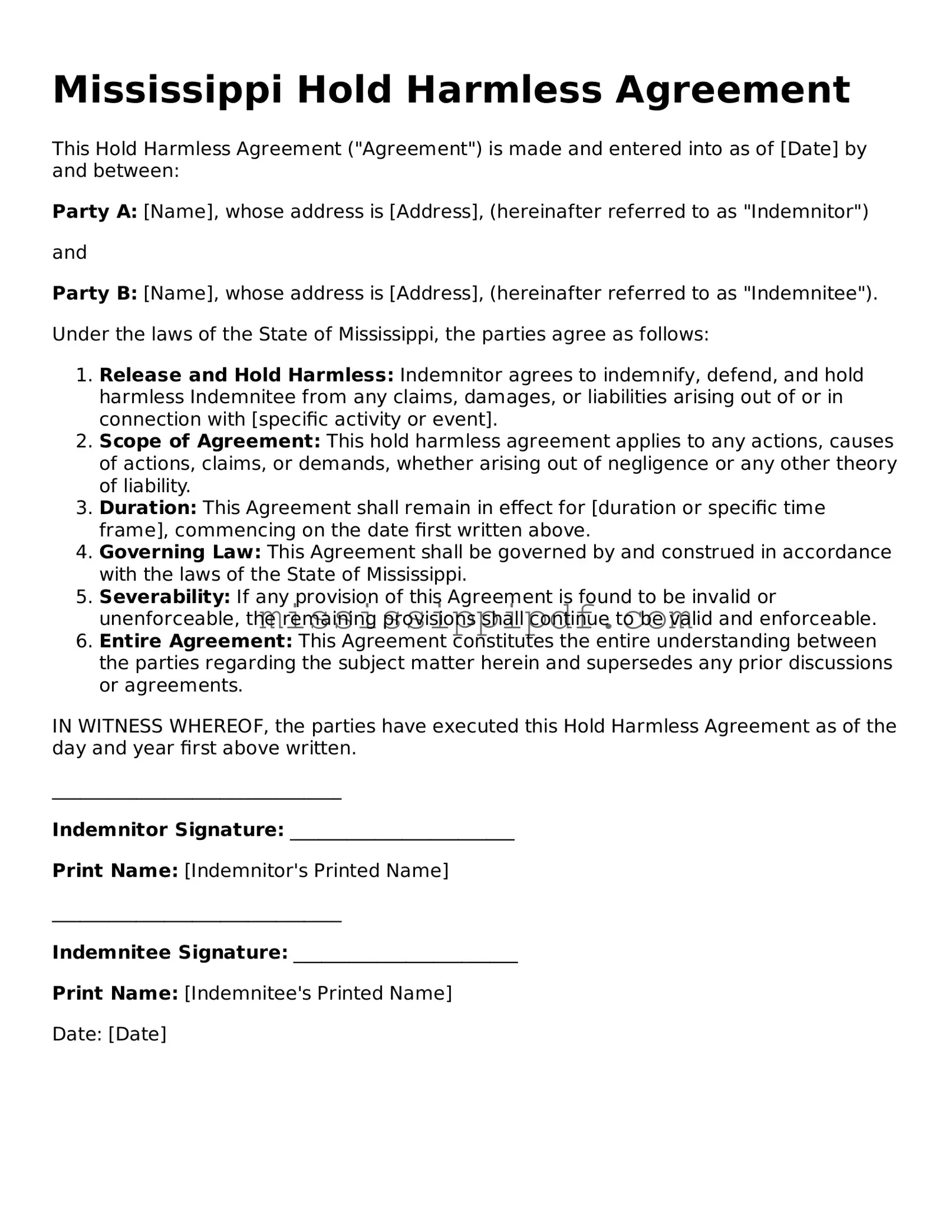The Release of Liability form is similar to the Mississippi Hold Harmless Agreement in that both documents protect one party from legal claims. When a participant engages in an activity, they may sign a Release of Liability to acknowledge the risks involved. This form indicates that the participant agrees not to hold the organizer responsible for any injuries or damages that may occur. Both agreements aim to minimize legal exposure and ensure that individuals take personal responsibility for their actions.
The Indemnity Agreement serves a similar purpose by ensuring that one party compensates another for certain damages or losses. In this case, if a party is sued or incurs expenses due to the actions of another, the indemnifying party agrees to cover those costs. Like the Hold Harmless Agreement, the Indemnity Agreement provides a level of protection and clarity regarding financial responsibilities in various situations.
A Waiver of Rights is another document that parallels the Mississippi Hold Harmless Agreement. This waiver allows individuals to relinquish their rights to pursue legal action against another party under specific circumstances. By signing this document, individuals acknowledge the risks involved and agree not to hold the other party liable for any resulting injuries. Both documents emphasize personal accountability and informed consent.
The Consent to Participate form is commonly used in activities involving inherent risks, such as sports or recreational events. This document informs participants of the risks and requires their agreement to participate despite those risks. Similar to the Hold Harmless Agreement, it aims to protect the organizing party from liability by ensuring that participants are aware of and accept the potential dangers involved.
The Non-Disclosure Agreement (NDA) is also related in terms of protecting parties from potential harm, albeit in a different context. An NDA prevents the sharing of confidential information between parties. While it does not address physical injury, it safeguards businesses and individuals from financial loss due to unauthorized disclosure. Both agreements seek to maintain trust and accountability between parties involved.
The Service Agreement often includes clauses that limit liability, making it comparable to the Hold Harmless Agreement. This document outlines the terms of service between two parties and can specify that one party will not be held responsible for certain types of damages. By clearly defining responsibilities and limitations, both agreements aim to prevent misunderstandings and potential legal disputes.
The Partnership Agreement can also share similarities with the Hold Harmless Agreement, particularly regarding liability among partners. This document outlines the roles, responsibilities, and liabilities of each partner in a business venture. It often includes provisions that protect partners from being held liable for the actions of others, thus promoting a sense of security and clarity in business relationships.
The Contractor Agreement frequently contains provisions that limit liability, making it akin to the Hold Harmless Agreement. When hiring contractors, businesses often include clauses that protect them from claims arising from the contractor's work. This agreement ensures that both parties understand their responsibilities and limits exposure to legal action, similar to the protective nature of a Hold Harmless Agreement.
Understanding the various legal documents that protect parties in different situations is essential, particularly for those involved in vehicle transactions. For example, the Arizona PDFs offers a comprehensive template for a Motorcycle Bill of Sale, ensuring both buyers and sellers have a clear record of the transfer of ownership and the terms involved in the transaction.
Lastly, the Event Liability Insurance policy is related in that it provides financial protection against claims arising from events. While not a legal agreement between parties, it serves to cover costs associated with injuries or damages that may occur during an event. Both the insurance policy and the Hold Harmless Agreement aim to mitigate risk and provide a safety net for individuals and organizations involved.
